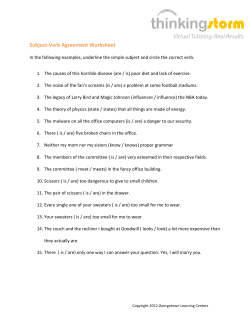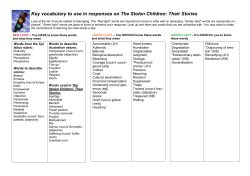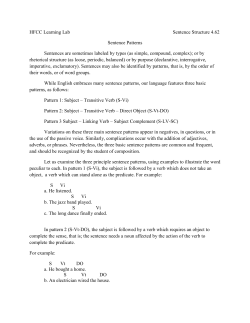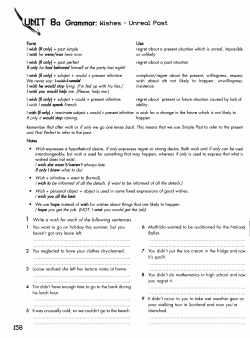
English Grammar Mechanics Mastery of and
Mastery of English Grammar and Mechanics ™ An Individualized Program P.O. Box 658 • Clayton, DE 19938 Tel: 1.800.932.4593 Web site: www.prestwickhouse.com ISBN: 978-1-58049-711-4 Copyright ©1998 by Prestwick House, Inc. Permission to use this unit for classroom use is extended to purchaser for his or her personal use. This material, in whole or part, may not be copied for resale. Revised March 2011 PRINTED IN THE U.S.A. Lesson One: A Few Simple Rules for Capitalizing Words Here are a few simple rules for capitalization. They do not cover every instance in which a capital letter should be used, but they do cover most. 1. Always capitalize the letter “I” when it is used to refer to yourself. 2. Always capitalize the first word in each sentence. 3. Always capitalize the first word in a direct quote. WRONG: The manager said, “shut up or get out.” RIGHT: The manager said, “Shut up or get out.” When a quote is broken, the second part is not capitalized unless it is a new sentence. WRONG: “Let’s not,” he stated, “Make any quick decisions.” RIGHT: “Let’s not,” he stated, “make any quick decisions.” 4. Capitalize a person’s name (or initials) and any title that comes before the name. WRONG: At that point, senator h. b. Jones and doctor joyce ray entered the room. RIGHT: At that point, Senator H.B. Jones and Doctor Joyce Ray entered the room. 5. Always capitalize the days of the week (Monday, Tuesday, etc.) and the months of the year (January, February, March, etc.); however, do not capitalize the seasons (fall, winter, spring, summer). WRONG: His birthday is friday, october 2, but mine is in the Summer. RIGHT: His birthday is Friday, October 2, but mine is in the summer. 6. Always capitalize the names of races, nationalities, languages, and religions. For example— African-American, Caucasian, Spanish, Irish, Methodist, Catholic. WRONG: The african-american was a baptist, and the spaniard was a catholic. RIGHT: The African-American was a Baptist, and the Spaniard was a Catholic. 7. Capitalize words referring to the Deity—God, the Savior, the Lord, Jehovah, Allah. 8. Always capitalize geographical areas (the North, the South) but not directions. WRONG: He found the pace of life slower in the south than in the north. RIGHT: He found the pace of life slower in the South than in the North. WRONG: He was traveling South on the interstate. RIGHT: He was traveling south on the interstate. 9. Always capitalize the first word and other important words in the name of a book, play, poem, or song. Do not capitalize unimportant words—in, on, the, for, at, etc. 19 Lesson One Lesson Two: A Few Simple Rules on Punctuation These rules do not cover every point of punctuation; however, if you master them, you will be well on your way to using punctuation correctly. 1. Use a period (.) at the end of a declarative sentence and after abbreviations and initials. Ex. Red is my favorite color. Dr., Co., H. L. Jones Note: Two-letter state abbreviations do not use periods and are written as two capital letters with no space between the letters. Ex. NJ, DE 2. If a sentence asks a question, use a question mark (?) at the end. Exclamation marks (!) are used to show great surprise, urgency, or strong feeling. Ex. Where are you going? Help! 3. Use a comma (,) to separate words or phrases in a series. 4. Use a comma to separate an appositive. (An appositive is a word or phrase that repeats the noun directly before it.) Ex. George Washington, our first president, is a hero for all of us. That book, Hamlet, belongs to me. Curling, the game that involves brooms and ice, is one of my favorites. 5. Use a comma in dates where you have three or more items together. Ex. The allies invaded Europe on June 6, 1944. Note: With two items, no comma is required, but one may sometimes be used. Ex. October 16 was the day to remember. 6. Use a comma to separate three items in an address, and/or to separate a city from a state. Ex. He lived at 21 Main St., Denver, Colorado. He lives in Denver, Colorado, but he is moving to Bradford, Florida, next month. 7. Use a comma to set off an introductory clause. (The sentence will usually begin with the word since, because, as, although, if, when, or a similar word.) Ex. Because he was going to be late, he took a key with him. Since it had stopped raining, she no longer needed an umbrella. 30 Lesson Two Ex. He bought eggs, milk, bread, and a paper. The gas entered the house through the open window, through the crack under the door, and down the open chimney. Lesson Three: Six Points to Remember When Using Quotation Marks 1. An indirect quote does not use quotation marks. (Indirect quotes are not someone’s exact words. They frequently begin the word “that.”) Ex. Direct quotes need quotation marks around the quoted statement. (Note the change in person in the pronouns.) Ex. 2. Ronald said that he disliked you. The mayor shouted that he would not be kicked around. Alvin replied he was late. (The word “that” is not stated, but it is implied.) Keisha’s exact words were not, “[I]f her mom would pick her up.” Ronald said, “I dislike you.” The mayor shouted, “I will not be kicked around.” Alvin replied, “I am late.” Keisha wondered, “Will mom pick me up?” The first word of a quote is always capitalized. Ex. The captain yelled, “Man the lifeboats!” “Man the lifeboats!” yelled the captain. The second part of a split quotation, however, is not capitalized. Ex. “I will,” the masked man said, “fight for truth, liberty and justice.” 3. Notice that the part of the sentence which is not written within the quotation marks is set off with commas. If the quotation is a split quotation, the stating phrase has a comma before and after it. Ex. “Our main goal,” the agent stated, “is to undermine the power of the dictator.” 4. Put a question mark inside the quotation marks if the direct quote is asking a question. Ex. “Who has a dollar?” Jane asked. Put an exclamation point inside the quotation marks if the direct quote is an exclamation. Ex. “I won a million dollars!” my father shouted. Note: Because of the question mark and exclamation point, no comma is needed at the end of the quote. 5. You need to place quotation marks around the titles of short stories, poems, and songs. Ex.In class we read Poe’s story called “William Wilson,” and for homework, we had to read his poem titled “The Bells.” Remember: The titles of books are not put in quotation marks; they are underlined or italicized. Ex. He lost his copy of Oliver Twist. 40 Lesson Three Lesson Four: Forming the Plural of Nouns 1. Most nouns form their plurals by simply adding an “s.” Singular boat + s = lawyer + s = germ + s = judge + s = cow + s = job + s = A number of other nouns, however, form their plurals differently. If you can remember these differences, your spelling will improve greatly. 2. The plurals of nouns ending in “s,” “sh,” “ch,” “x,” and “z” are formed by adding “es.” Singular box + es = class + es = ditch + es = flash + es = fizz + es = 3. Nouns ending in “y” preceded by a consonant form their plurals by changing the “y” to “i” and adding “es.” Singular city change y to i + es = baby change y to i + es = company change y to i + es = 4. For nouns ending in “y” preceded by a vowel (a, e, i, o, u), simply add an “s” to form their plurals. Singular toy + s = monkey + s = day + s = buy + s = 5. Most nouns ending in “o” add an “s” to form their plurals, Singular rodeo + s = radio + s = duo + s = trio + s = piano + s = solo + s = auto + s = Plural boats lawyers germs judges cows jobs Plural boxes classes ditches flashes fizzes Plural cities babies companies Plural toy monkeys days buys Lesson Four Plural rodeos radios duos trios pianos solos autos 50 Lesson Five: Apostrophes to Show Possession The most common use of the apostrophe is to form the possessive case of nouns. Ex. 2. The possessive case of singular nouns which do not end in “s” is formed by adding an apostrophe and an “s” to the end of the word. Noun the coat of the boy the face of the man the pen of the woman 3. The possessive case of plural nouns or of nouns which end in “s” is formed by adding just the apostrophe to the end of the word. Noun the windows have a glare the hats of the girls nests belonging to the birds the handles of the axes Note to the Teacher: We realize that some style guides separate this rule into two sections [Dickens’s, business’s, Moses’, octopus’ as examples], but for the sake of consistency and the grade level of this booklet, we have decided to use only the one rule. 4. The possessive case of plural nouns that do not end in “s” is formed by adding an apostrophe and an “s” directly to the noun. Noun the pictures of the men the boots of the children The boy’s boat. (means “The boat belongs to the boy.”) Possessive the boy’s coat the man’s face the woman’s pen Possessive the windows’ glare the girls’ hats the birds’ nest the axes’ handles Possessive the men’s pictures the children’s boots 56 Lesson Five 1. Lesson Six: Parts of Speech A noun is a word that names a person, place, thing, or idea. Nouns may be classified as common, proper, abstract, or collective. Common nouns name a class of persons, places, or things. They are not specific, and they are not capitalized. Ex. actor, country, holiday, mountain, celebration, etc. Proper nouns name specific persons, places, events, or things and must be capitalized. Ex. Tom Cruise, France, Thanksgiving, California, etc. Abstract nouns name abstract ideas and qualities. Ex. loyalty, love, freedom, faith, hatred, patriotism, etc. Collective nouns name groups of persons, animals, or things. Ex. flock, family, army, crowd, bunch, etc. A pronoun is a word used in place of a noun. Ex. John is late; he is always late. The train is on time; it is always on time. Pronouns are classified as personal, demonstrative, interrogative, possessive, reflexive, or relative. Explanations and examples of these different types of pronouns follow. Personal pronouns refer to persons or things. Ex. I, me, you, he, him, she, her, it, we, us, they, them I gave the message to her early in the morning. The fog was gone; it had lasted all night. Demonstrative pronouns are used to identify specific nouns without naming them. Ex. this, that, these, those I want those. Those flowers were picked from a garden in the early morning. Interrogative pronouns are used in questions. Ex. who, which, what, whom, whose Which student won the $10,000 scholarship? Whose sweater is this? What did you say? 64 Lesson Six Lesson Seven: Subjects and Predicates 1. The subject of the sentence is a word, phrase, or clause which identifies the performer of the action. It is the topic, the thing, the person which the sentence is about. Ex. Tom threw the ball. (Tom is a noun, the performer of the action.) The poor runner collapsed from exhaustion. (The poor runner is a noun phrase performing the action. Runner is the subject noun.) The noun in the subject is called the simple subject. In our exercises, it is the simple subject we will ask you to identify. 2. Although in most sentences the subject begins the sentence, sometimes the subject will follow an introductory phrase or clause. Ex. In the afternoon, I usually take a nap. 3. In interrogative sentences (questions), the subject often comes after part of the verb. Ex. Did you eat your peas? 4. In many imperative or exclamatory sentences (direct commands), the subject is often not expressed, but is understood to be “you.” 5. In sentences using passive voice, the subject is the receiver of the action rather than the performer, but it is still the topic or focus of the sentence. Ex. Bill was hit by the ball. (Bill is the subject.) 6. When searching for the simple subject, first cross out all prepositional phrases. The simple subject is never in a prepositional phrase. Remembering this rule will eliminate many problems in identification of subjects it will also help your writing. Ex. In the morning one of the sailors got sick. (The subject is one, not sailors.) One student in all grades can attend. (The subject is student, not grades.) 7. The predicate of the sentence is everything in the sentence that is not the subject or part of the subject. It contains the verb and its modifiers and complements. Ex. Simon cried. (verb) Christine hugged Paul. (verb, direct object) John gave Sue the ring. (verb, indirect object, direct object) The rocket exploded on the launching pad. (verb, prepositional phrase) The verb, with any helping verbs, is called the simple predicate. We have circled the simple subject and underlined the simple predicate. Ex. In the morning, Frank will give you the details. Many of the members of the soccer team were honored for their work for charities. 76 Lesson Seven Ex. Eat your peas. (You) eat your peas. Lesson Eight: Agreement of Subject and Predicate In the present tense, most verbs remain unchanged except for the use of he, she, or it. In this instance, the verb takes an “s.” Ex. I walk (we walk) you walk (you walk) he, she, it walks (they walk) Most of the time, you won’t have a problem with this agreement. Here are some problem areas: 1. When words come between the subject and verb. Ex. One of the boys (walk, walks) the fastest. In this sentence, one is the subject, not boys; therefore, the singular subject one agrees with the singular, third person, walks. The phrase “of the boys” is a prepositional phrase. To make sure you know the subject, first cross out any prepositional phrases. If you are still unsure, try the pronoun substitution check. Ex. One of the boys (drive, drives) the best. One of the boys (he) drives the best. Of all the girls in the troop, Janice and Sally (was, were) the most helpful. Of all the girls in the troop, Janice and Sally, (they) were the most helpful. Remember: of, on, from, with, to, in, for, by, at are the most common introduction to prepositional phrases. 2. The following pronouns are almost always used with singular verbs. Memorize them. Ex. anyone someone no one Ex. Everybody in the room (is, are) listening. Substitution check: Every single person in the room is listening. 3. everybody (every single person) nobody (no single person) somebody (some single person) Each of the boys has his own. (has, have) Substitution check: Each one of the boys has his own. Although there are exceptions, none (not one) and any (any single one) are generally singular. Ex. None of us drives. (not one of us) Any of the actors is ready. (any single actor) 4. The following pronouns are always used with plural verbs: Ex. several, both, few, many Several in this box were broken. (they were) Both of the doors in the cabinet have opened. (they have) 88 Lesson Eight each one everyone Lesson Nine: Direct Objects, Indirect Objects, and Objects of the Preposition Note: The direct object, indirect object, and object of the preposition are always nouns or pronouns. 1. The direct object is the receiver of the action of the verb. Ex. Tom threw the ball. (Threw is the verb or simple predicate.) Who threw it? (Tom threw it—Tom is the subject.) Tom threw what? (Tom threw the ball—ball is the direct object.) Ex. My father lost his wallet. What did my father lose? (Wallet—wallet is the direct object.) 2. The indirect object is the receiver of the direct object. Ex. Tom threw me the ball. (Verb—threw / Subject—Tom) What did Tom throw? (Direct Object—ball) Who received the ball? (me—me is the indirect object.) Ex. John gave Mary a note. John gave what? (A note—note is the direct object.) Who received the note? (Mary—Mary is the indirect object.) A way to test for the indirect object is to put “to” in front of the word. If the sentence makes sense, you know it is the indirect object. Ex. Tom threw me the ball. (Tom threw the ball (to) me.) John gave Mary a note. (John gave a note (to) Mary) Notes: 1.) You will not find either object in a prepositional phrase. 2.) If you have an indirect object, you must have a direct object, but the reverse is not true. 3.) The indirect object is always closer to the verb. 3. The object of a preposition is the noun or pronoun in a prepositional phrase. Sometimes there can be more than one object. Note: A prepositional phrase must be introduced by a preposition. (What are the seven most common prepositions?) In the following example, we have boxed in the preposition, underlined the prepositional phrase, and put parentheses around the object of the preposition. Ex. A friend [of] (mine) sat [in] the (corner) [with] the (box). Two children played [with] the (blocks) and the toy (hammers). Lesson Nine 98 Lesson Ten: Case of Pronouns A pronoun may be the subject, indirect object, direct object, object of preposition, or predicate nominative of a sentence. The form of the pronoun depends on how the word functions in the sentence. Ex. (She, Her) brought it to school. You use “she” here because the word is the subject of the sentence; thus you need the subjective form, “she.” Ex. Between you and (I, me), he is not so great. You use “me” here because the word is the object of the preposition “between,” so you need the objective form, “me.” Pronouns in the nominative case are used as subjects and/or predicate nominatives. Pronouns in the objective case are used as direct objects, indirect objects, or objects of the preposition. Pronouns in the possessive case show ownership. Nominative I we you he she it they who Ex. Objective me us you him her it them whom Possessive my/mine our/ours your/yours his her/hers its their/theirs whose It is they. (predicate nominative) He took the book home. (subject) The teacher failed him. (direct object) Actually the whole thing was his fault. (possessive modifier) Note this sentence. Ex. He cannot run as well as (they, them). In this sentence there are two clauses: Ex. He cannot run and they (can run). Although the verb in the second clause (can run) is understood, it is still the predicate of the clause so the subject (they) is in the nominative case. 105 Lesson Ten Lesson Eleven: Clauses, Sentences, and Fragments A clause is any group of words containing a subject and a predicate and joined together as a unit of thought. 1. A main or independent clause is a clause which can stand on its own as a complete sentence. It is a complete thought by itself. Ex. I like candy. Many people go to night school. Mindy told Vinny a lie about his sister. A subordinate or dependent clause is a clause that contains a subject and verb, but which cannot stand on its own as a complete sentence. It does not contain enough information and does not make sense by itself. A subordinate clause is introduced by a subordinate conjunction. Ex. When the warm weather arrives, If you don’t believe me, 3. Any subordinate clause left to stand alone as a complete sentence is called a sentence fragment. It makes no sense on its own, and it must be connected to a main clause to become a complete sentence. Ex. After you leave. (fragment) After you leave, I’ll do my homework. (sentence) When the warm weather arrives. (fragment) When the warm weather arrives, I will plant a garden. (sentence) 4. A sentence containing only one main clause is called a simple sentence. 5. A sentence which contains at least one main clause and one subordinate clause is called a complex sentence. Ex. If you leave now, / you’ll never come back. I’ll call you / when I want you. 6. A sentence which contains at least two main clauses is called a compound sentence. Ex. Mr. Smith ate the ice cream, and Mrs. Smith ate the pudding. Donna danced all night, / but no one asked me. Would you like coffee, / or do you prefer tea? It was an awful night; / both kids were sick. Note that main clauses are joined either by a coordinating conjunction (and, but, or, nor, for, yet, so) or by a semicolon (;). 118 Lesson Eleven 2.
© Copyright 2025



















